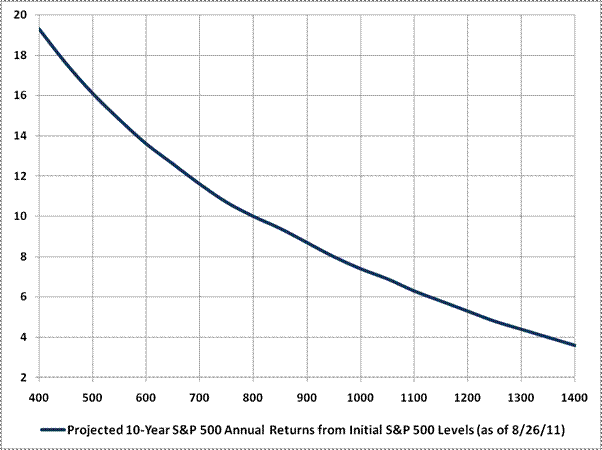Recession Watch:
6 Signatures of recessions:
1. widening of credit spreads on corporate debt versus 6 months prior
2. S&P 500 below its level of 6 months prior
3. Treasury yield curve flatter than 2.5% (10-year minus 3-month)
4. year-over-year GDP growth below 2%
5. ISM Purchasing Managers Index below 54
6. year-over-year growth in total nonfarm payrolls below 1%
.......as well as important corroborating indicators, such as plunging consumer confidence
...the evidence we observe at present has 100% sensitivity (these conditions have always been observed during or just prior to each U.S. recession) and 100% specificity (the only time we observe the full set of these conditions is during or just prior to U.S. recessions).
Excerpts from: A Reprieve from Misguided Recklessness, John P. Hussman, August 29, 2011:
hussmanfunds.com
Valuation Review: As of last week, we estimate that the prospective 10-year total return for the S&P 500 is back down to about 5.1% annually. To put this expected return in perspective, the chart below reviews the prospective return estimates from our standard methodology, going back to just before the Great Depression. The chart also presents the actual subsequent 10-year total returns achieved by the S&P 500. Note that a 5.1% prospective return is certainly not the worst level we've observed in history, but it is far from the 7.5-13% range of prospective returns that has characterized the bulk of historical data (and of course nowhere near the 20% prospective returns that have marked "secular" market lows).

The chart below provides a more comprehensive view of the prospective returns that would be associated with various levels of the S&P 500, based on the fundamentals we presently observe. As a rule-of-thumb, this curve shifts to the right at a rate of about 6% annually, which is the approximate growth rate of long-term normalized fundamentals (earnings, dividends, book values, revenues, and even nominal GDP).

...each time the Fed has attempted to "backstop" the financial markets by distorting the set of investment opportunities that are available, the Fed has bought a temporary reprieve only at the cost of amplifying the later fallout....
The way to get out of this is to abandon the misguided belief that economic prosperity can be obtained by encouraging speculation and distorting the set of investment opportunities. Rather, we will eventually find, as was eventually also discovered in the post-Depression stagnation of the 1930's, that the way to get the economy moving again is to restructure hopelessly burdensome debt obligations....
Over the past three years, Wall Street and the banking system have enjoyed enormous fiscal and monetary concessions on the self-serving assertion that the global financial system will "implode" if anyone who made a bad loan might actually experience a loss. Because reversing this mantra is so difficult, policy makers are likely to continue fitful efforts to "rescue" this debt for the sake of bondholders, through mechanisms that are increasingly distasteful to the broader population.....
.......with near-zero interest rates, depressed long-term rates, and already massive bank reserves, the policy could not hope to relieve any constraints that were actually relevant to the economy (see The Recklessness of Quantitative Easing ); because consumers don't spend out of volatile forms of "wealth" (see Bubble, Crash, Bubble, Crash, Bubble... ); and because a monetary easing that creates inflation expectations while pressing down interest rates invariably leads to an "overshooting" depreciation in that currency and a surge in commodity prices that are quoted in that currency (see Why Quantitative Easing is Likely to Trigger a Collapse of the U.S. Dollar ) |






